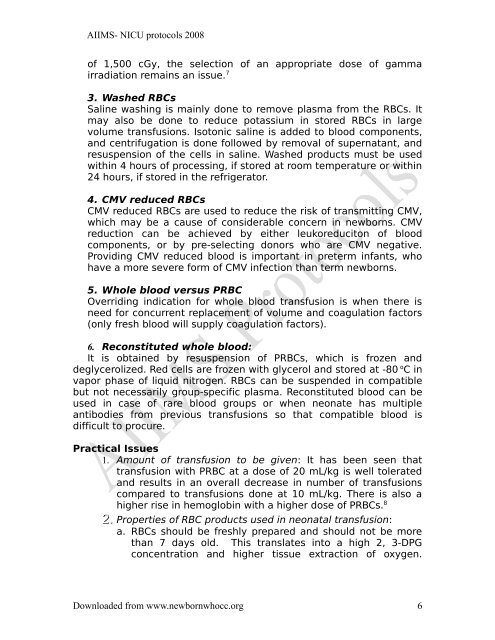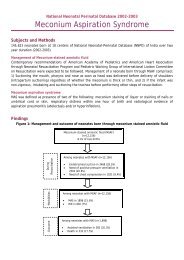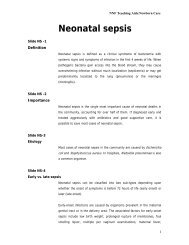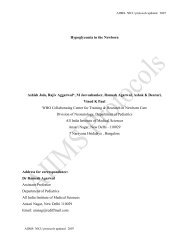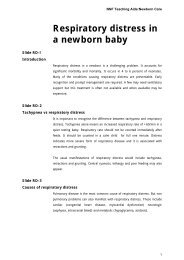Blood and blood component therapy in neonatology - New Born Baby
Blood and blood component therapy in neonatology - New Born Baby
Blood and blood component therapy in neonatology - New Born Baby
Create successful ePaper yourself
Turn your PDF publications into a flip-book with our unique Google optimized e-Paper software.
AIIMS- NICU protocols 2008<br />
of 1,500 cGy, the selection of an appropriate dose of gamma<br />
irradiation rema<strong>in</strong>s an issue. 7<br />
3. Washed RBCs<br />
Sal<strong>in</strong>e wash<strong>in</strong>g is ma<strong>in</strong>ly done to remove plasma from the RBCs. It<br />
may also be done to reduce potassium <strong>in</strong> stored RBCs <strong>in</strong> large<br />
volume transfusions. Isotonic sal<strong>in</strong>e is added to <strong>blood</strong> <strong>component</strong>s,<br />
<strong>and</strong> centrifugation is done followed by removal of supernatant, <strong>and</strong><br />
resuspension of the cells <strong>in</strong> sal<strong>in</strong>e. Washed products must be used<br />
with<strong>in</strong> 4 hours of process<strong>in</strong>g, if stored at room temperature or with<strong>in</strong><br />
24 hours, if stored <strong>in</strong> the refrigerator.<br />
4. CMV reduced RBCs<br />
CMV reduced RBCs are used to reduce the risk of transmitt<strong>in</strong>g CMV,<br />
which may be a cause of considerable concern <strong>in</strong> newborns. CMV<br />
reduction can be achieved by either leukoreduciton of <strong>blood</strong><br />
<strong>component</strong>s, or by pre-select<strong>in</strong>g donors who are CMV negative.<br />
Provid<strong>in</strong>g CMV reduced <strong>blood</strong> is important <strong>in</strong> preterm <strong>in</strong>fants, who<br />
have a more severe form of CMV <strong>in</strong>fection than term newborns.<br />
5. Whole <strong>blood</strong> versus PRBC<br />
Overrid<strong>in</strong>g <strong>in</strong>dication for whole <strong>blood</strong> transfusion is when there is<br />
need for concurrent replacement of volume <strong>and</strong> coagulation factors<br />
(only fresh <strong>blood</strong> will supply coagulation factors).<br />
6. Reconstituted whole <strong>blood</strong>:<br />
It is obta<strong>in</strong>ed by resuspension of PRBCs, which is frozen <strong>and</strong><br />
deglycerolized. Red cells are frozen with glycerol <strong>and</strong> stored at -80 o C <strong>in</strong><br />
vapor phase of liquid nitrogen. RBCs can be suspended <strong>in</strong> compatible<br />
but not necessarily group-specific plasma. Reconstituted <strong>blood</strong> can be<br />
used <strong>in</strong> case of rare <strong>blood</strong> groups or when neonate has multiple<br />
antibodies from previous transfusions so that compatible <strong>blood</strong> is<br />
difficult to procure.<br />
Practical Issues<br />
1. Amount of transfusion to be given: It has been seen that<br />
transfusion with PRBC at a dose of 20 mL/kg is well tolerated<br />
<strong>and</strong> results <strong>in</strong> an overall decrease <strong>in</strong> number of transfusions<br />
compared to transfusions done at 10 mL/kg. There is also a<br />
higher rise <strong>in</strong> hemoglob<strong>in</strong> with a higher dose of PRBCs. 8<br />
2. Properties of RBC products used <strong>in</strong> neonatal transfusion:<br />
2.<br />
a. RBCs should be freshly prepared <strong>and</strong> should not be more<br />
than 7 days old. This translates <strong>in</strong>to a high 2, 3-DPG<br />
concentration <strong>and</strong> higher tissue extraction of oxygen.<br />
Downloaded from www.newbornwhocc.org 6


